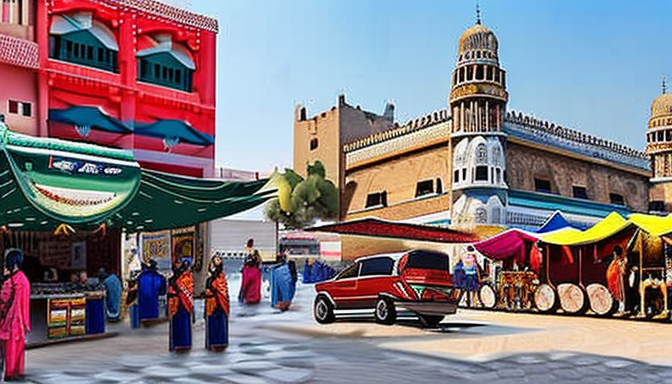Karachi is not just a city; it’s a living story. Imagine walking through the streets where history whispers in every corner. This bustling metropolis started as a humble fishing village, where the sea was both a livelihood and a lifeline. Over the years, it transformed into a vibrant urban hub, teeming with life and culture.
What does this journey look like? Picture vintage photographs capturing the essence of Karachi’s past. These images reveal a city that has always been dynamic. From the majestic colonial architecture to the colorful bazaars, each snapshot tells a tale of resilience and change. Historical maps, too, show how Karachi expanded, swallowing up the coastline and evolving into a sprawling urban landscape.
As you explore these visual treasures, you might wonder: how did Karachi become the melting pot it is today? The answer lies in its rich tapestry of cultures. Influences from various communities have woven together to create a unique identity. From the bustling streets of Saddar to the serene beaches of Clifton, Karachi is a mosaic of experiences waiting to be discovered.
So, grab your camera and embark on this visual journey. Let the stunning snapshots of Karachi’s history inspire you. Each photo is a window into the past, inviting you to reflect on how far this city has come. The next time you walk its streets, remember the stories hidden in every brick and alley.
Historical Milestones
Karachi’s journey is like a rich tapestry, woven with threads of time, culture, and resilience. This city started as a humble fishing village and has blossomed into a bustling metropolis. It’s fascinating to think about how a small settlement transformed into one of the largest cities in the world. Each era has left its mark, shaping the Karachi we know today.
One of the most significant milestones was the establishment of Karachi as a port in the early 19th century. This transformation opened the floodgates to trade and commerce. Suddenly, Karachi became a melting pot of cultures. Merchants from all over the world came, bringing with them their traditions, languages, and cuisines. Can you imagine the lively markets filled with spices, textiles, and stories from distant lands?
Throughout the years, Karachi has faced numerous challenges and changes. The partition of India in 1947 was a pivotal moment. The city saw a massive influx of refugees, which reshaped its demographic landscape. This was not just a challenge; it was an opportunity for Karachi to grow and evolve. The vibrant mix of cultures enriched the city’s heritage, making it a unique blend of traditions.
To truly appreciate this evolution, one can take a visual journey through vintage photographs and historical maps. These snapshots reveal how Karachi has transformed from a sleepy fishing village to a vibrant urban center. Each image tells a story, capturing the essence of the city at different times. It’s like opening a time capsule, where every picture speaks volumes about the past.

Cultural Heritage
Karachi’s is a vibrant tapestry woven from diverse threads. Over the years, this city has absorbed influences from various cultures, making it a melting pot of traditions. Picture this: a bustling street where the aroma of spicy biryani mingles with the sweet scent of jalebi. It’s a feast for the senses! The flavors tell stories of the city’s past, each bite a chapter in its rich history.
As you stroll through Karachi, you’ll notice the stunning architecture that reflects its historical evolution. From the colonial buildings in Saddar to the modern skyscrapers in Clifton, each structure has its own tale. Have you ever wondered how these designs came to be? They are like frozen moments in time, showcasing the artistic styles of different eras.
Let’s not forget the languages spoken here. Karachi is home to a multitude of languages, including Urdu, Sindhi, and English. This linguistic diversity is a testament to the city’s inclusive spirit. Each language adds its own flavor to the cultural mix, making conversations lively and engaging.
To truly appreciate Karachi’s heritage, consider visiting local museums or cultural festivals. These places often display vintage photographs and historical maps that showcase how Karachi has transformed. It’s like stepping into a time machine! You can see how the city has evolved, from a humble fishing village to a bustling metropolis.
In summary, Karachi is not just a city; it’s a living history. Its cultural heritage is a beautiful blend of flavors, languages, and architectural marvels. So, next time you’re in Karachi, take a moment to soak it all in. You might just find a piece of history that resonates with you.
Frequently Asked Questions
- What is the historical significance of Karachi?
Karachi has a rich history, evolving from a humble fishing village to a major metropolis. It has witnessed significant events, including British colonial rule and the partition of India, which have shaped its cultural and architectural landscape.
- How has the cultural heritage of Karachi influenced its cuisine?
The diverse cultural influences in Karachi have resulted in a vibrant culinary scene. From spicy Sindhi biryani to sweet Karachi halwa, the city’s food reflects a blend of traditions and flavors that tell the story of its past.
- What are some must-visit historical sites in Karachi?
When in Karachi, you can’t miss landmarks like the Quaid-e-Azam’s Mausoleum, Mohatta Palace, and the historic Empress Market. Each site offers a glimpse into the city’s rich history and architectural beauty.
- How can I learn more about Karachi’s history?
There are plenty of resources available! You can explore local museums, attend guided tours, or read books and articles focused on Karachi’s history. Engaging with locals can also provide unique insights into the city’s past.